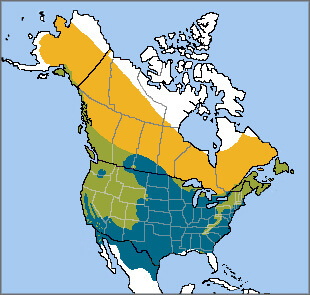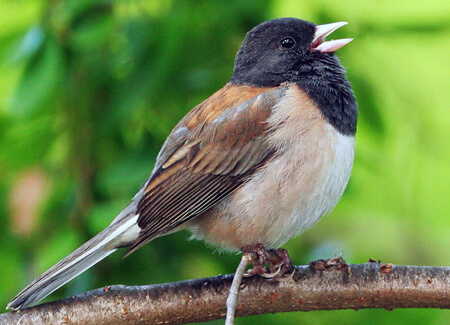 “There is not an individual in the Union who does not know the little Snow-bird,” declared John James Audubon, writing about the Dark-eyed Junco almost 200 years ago. Many people in the United States today still think of this familiar songbird as the “snowbird,” since it seems to show up in backyards and other suburban habitats just as winter settles in.
“There is not an individual in the Union who does not know the little Snow-bird,” declared John James Audubon, writing about the Dark-eyed Junco almost 200 years ago. Many people in the United States today still think of this familiar songbird as the “snowbird,” since it seems to show up in backyards and other suburban habitats just as winter settles in.
Like other widespread species such as the Common Yellowthroat and the Swainson's Thrush, Dark-eyed Junco populations vary by plumage, size, vocalizations, and behavior across their range, accounting for what one scientist calls a “turbulent” taxonomic history.
Turbulent Taxonomy
The Dark-eyed Junco has a wide distribution across Canada and the United States, also reaching northern Mexico; strays have been reported from the Caribbean and even Europe.
All Dark-eyed Juncos have some features in common: white outer tail feathers that are especially conspicuous when the bird takes flight; darker upperparts contrasting a lighter belly; and a pale bill. But this bird can vary drastically in appearance depending on where one sees it. Some juncos have more reddish-brown on the back and sides, some sport a contrasting dark hood over the head and neck, and others show a gray-tinged belly or white bars on the wings.
The Dark-eyed Junco was classified as five separate species until the 1970s, when the American Ornithologists' Union (AOU) combined them, based on the most current scientific data. The AOU then subdivided the newly created species into separate groups, each with its previous common and scientific names: Slate-colored Junco (hyemalis); White-winged Junco (aikeni); Oregon Junco (oreganus); Gray-headed Junco (caniceps); and Guadalupe Junco (insularis).
Splits and Lumps
Although initially lumped with the rest of the Dark-eyed group, the endemic Guadalupe Junco was again split into a distinct species in 2016. Another closely related species, the Yellow-eyed Junco, is resident in pine-oak highlands from southeastern Arizona and southwestern New Mexico south through Mexican highlands to Guatemala.
Scientists recognize approximately 16 subspecies within the Dark-eyed Junco groups; to complicate matters even further, there is much overlap between the groups and different subspecies. Some scientists do not recognize the AOU's reclassification of the Dark-eyed Junco and still consider some or all of these groups as separate species. The debate goes on even today.
Sweet Trill of the Snowbird
Male Dark-eyed Juncos sing a sweet, high-pitched trill that sounds similar to the songs of the Chipping Sparrow and Pine Warbler. All three species are often found in the same habitat, posing a unique auditory challenge to birders.
(Recording credits: Junco – Peter Boesman, XC322995. Accessible at www.xeno-canto.org/322995. Pine Warbler – Ross Gallardy, XC308664. Accessible at www.xeno-canto.org/308664. Chipping Sparrow – Antonio Xeira, XC383963. Accessible at www.xeno-canto.org/383963.)
Sign up for ABC's eNews to learn how you can help protect birds
Frequent FeederWatch Visitor
Dark-eyed Juncos, like other members of the sparrow family including Song Sparrow and Vesper Sparrow, rely on seeds for most of their diet, adding insect protein during the breeding season.
During the winter, juncos readily come to backyard feeders for millet and sunflower seeds, foraging on the ground in small flocks with White-throated Sparrows, Northern Cardinals, and other common backyard birds such as finches and doves. Dark-eyed Juncos are one of the most common species noted during the Cornell Lab of Ornithology's annual Project FeederWatch, a citizen science program that compiles volunteers' backyard count data.
Keeping the Snowbird Common
Although still considered common, Partners in Flight data show that Dark-eyed Junco populations declined by over 40 percent in the last several decades. Like many other bird species, this species is vulnerable to habitat loss and is a frequent victim of window collisions.
The closely related Guadalupe Junco, found only on the Mexican island that inspired its name, is considered Endangered by the International Union for Conservation of Nature (IUCN). Like other island endemics, such as Hawai'i's Palila, the Guadalupe Junco is particularly vulnerable to predation by introduced species such as cats.
ABC's advocacy programs, including Cats Indoors and Glass Collisions, continue work to reduce or remove some of the challenges facing Dark-eyed Juncos across their wide range.
Donate to support ABC's conservation mission!




















































